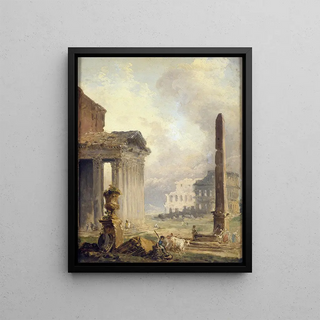Art print | Roman Ruins of the Forum with the Colosseum and the Obelisk - Hubert Robert


View from behind

Frame (optional)
Art print Rome Ruins of the Forum with the Colosseum and the Obelisk - Hubert Robert – Captivating Introduction
In the rich and complex panorama of 18th-century art, the work "Rome Ruins of the Forum with the Colosseum and the Obelisk" by Hubert Robert stands out for its ability to transport the viewer on a journey through time. This painting, imbued with nostalgia and timeless beauty, evokes the majestic remnants of ancient Rome while offering a romantic vision of history. Hubert Robert, a true architect of dreams, invites us to explore the ruins of a glorious past, where imagination and reality blend harmoniously. Each brushstroke reveals an atmosphere filled with serenity, where light dances on ancient stones, creating a living tableau that touches the soul.
Style and uniqueness of the work
Hubert Robert's style is characterized by a keen sense of detail and exceptional mastery of light. In "Rome Ruins of the Forum with the Colosseum and the Obelisk," the artist demonstrates his ability to recreate architectural landscapes with almost photographic precision. Architectural elements, such as the Colosseum and the obelisk, are rendered with such delicacy that they seem to breathe, conveying a sense of grandeur and eternity. The color palette chosen by Robert, oscillating between warm tones and soft shades, contributes to the calming atmosphere of the piece. The composition, meanwhile, is carefully balanced, guiding the viewer's gaze through the ruins while allowing appreciation of the beauty of the details. This work stands out for its ability to merge the real and the imaginary, offering a romantic vision of ancient Rome, where the past blends with poetic reverie.
The artist and his influence
Hubert Robert, often nicknamed the "painter of ruins," captured the very essence of nostalgia through his works. Born in Paris in 1733, he was deeply influenced by his travels in Italy, where he was able to admire the remnants of past civilizations. His work bears witness to a fascination for the

Matte finish

View from behind

Frame (optional)
Art print Rome Ruins of the Forum with the Colosseum and the Obelisk - Hubert Robert – Captivating Introduction
In the rich and complex panorama of 18th-century art, the work "Rome Ruins of the Forum with the Colosseum and the Obelisk" by Hubert Robert stands out for its ability to transport the viewer on a journey through time. This painting, imbued with nostalgia and timeless beauty, evokes the majestic remnants of ancient Rome while offering a romantic vision of history. Hubert Robert, a true architect of dreams, invites us to explore the ruins of a glorious past, where imagination and reality blend harmoniously. Each brushstroke reveals an atmosphere filled with serenity, where light dances on ancient stones, creating a living tableau that touches the soul.
Style and uniqueness of the work
Hubert Robert's style is characterized by a keen sense of detail and exceptional mastery of light. In "Rome Ruins of the Forum with the Colosseum and the Obelisk," the artist demonstrates his ability to recreate architectural landscapes with almost photographic precision. Architectural elements, such as the Colosseum and the obelisk, are rendered with such delicacy that they seem to breathe, conveying a sense of grandeur and eternity. The color palette chosen by Robert, oscillating between warm tones and soft shades, contributes to the calming atmosphere of the piece. The composition, meanwhile, is carefully balanced, guiding the viewer's gaze through the ruins while allowing appreciation of the beauty of the details. This work stands out for its ability to merge the real and the imaginary, offering a romantic vision of ancient Rome, where the past blends with poetic reverie.
The artist and his influence
Hubert Robert, often nicknamed the "painter of ruins," captured the very essence of nostalgia through his works. Born in Paris in 1733, he was deeply influenced by his travels in Italy, where he was able to admire the remnants of past civilizations. His work bears witness to a fascination for the






